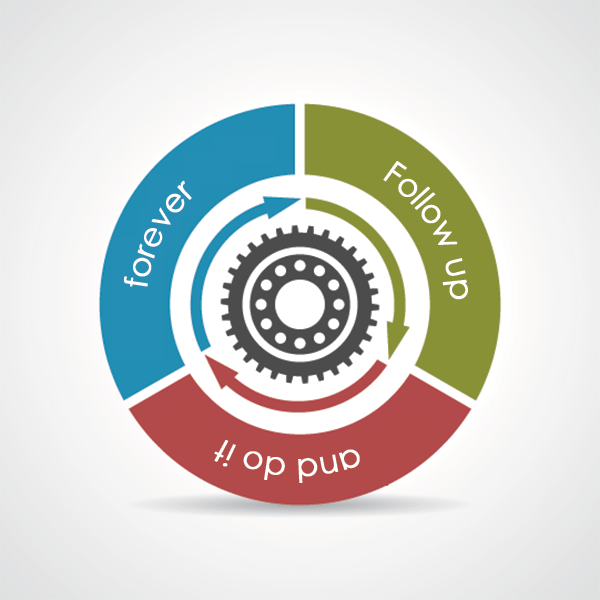‘Follow up, and do it forever.’
For those in professional services (which includes accountants), follow up is not only important – it’s your marketing lifeline.

Follow up is an area which many accountants struggle with – mostly because of the tendency to get really excited about new prospects. Prospecting and new clients are fun, and exciting, and you get a bit of a rush when someone tells you how pleased they are to have an accountant who understands them at last (or something similar).
But there’s often an expectation that the prospect will either say yes, and start right away – or say no, and go somewhere else.
The truth is that most prospects fall somewhere in the middle.
They might like you, and your firm, and have a good impression from your discussions. But then they took on a new project or lost a few customers or hired a new employee – and their previously urgent need for an accountant has faded a little.
Or, they might not be sure quite yet if they want to change accountants. They are considering it, but then their current accountant actually sent them what was promised so they figure they can hold on for a few months more.
They’re still interested, but they’re no longer ready.
This percentage of your prospects is quite a high number.
It could be between 50 and 80% of those who contact you are just not ready to work with you – yet. And if you don’t follow up (and do it forever), you will lose touch with them and each of you will move on.
For almost all of these prospects though, they will eventually do business with either you or someone similar to you, when the time is right.
So how do you ensure that when the time is right, you are the one that they come back to? That you are the accountant they still want to do business with, two months or six months or even six years down the line?
Patient and steady follow up is the key.
When I say ‘patient and steady’, that’s because there is a fine line between follow up and stalking. (More on that next week.)
Here are a few tips to help you with follow up on enquiries for accounting services:
1. Have a clear system to record and track your leads.
This can be as simple as a document in Excel – and this is coming from someone who really hates Excel! (I use it for a few areas of our own business but it is my life goal not to ever have to use it again. I much prefer online apps that are integrated and collaborative! Rant over.) Here are a few options if you don’t have a system yet:
- a. Excel sheet (see notes above). Collaborate in Dropbox or Google Drive.
- b. Mailchimp. You can segment your Mailchimp list into prospects, hot leads, warm leads, cold leads, etc.
- c. Your current CRM system. Whatever you use, figure out a way to keep a running list of enquiries that the whole team can access – and to keep prospects on your mailing list so that you can keep sending them helpful information.
- d. Your new CRM system. If you’ve been mulling over that new CRM system for a long time, just go for it, and use this as your excuse. Start by using it for prospects and leads, and add more as you go along.
2. Have a very simple system to record and track your leads!
I can’t emphasise enough that your system has to be simple, or else you won’t use it, and neither will your team. If any of the above suggestions prevent you from using your brilliant new system, pick another one. If you have to use a pen and paper, do that (although that does make collaboration a little difficult).
3. Track the basics. Here are a few basic fields that you should be tracking:
- a. First name, last name (obviously)
- b. Company name
- c. Email address
- d. Phone number
- e. Type of business (this depends on your marketing purposes. If you market by niche or industry or issue, you’ll want to identify this up front – ie, creative agency, cash flow issues, auto enrolment)
- f. Originating source (see point 4 below)
- g. Product or service enquired about
- h. Notes (what did they tell you beyond the basics?)
4. Always identify where the prospect originated – the first time.
The challenge with online marketing is that people engage with you using so many different means (website, social media, email, webinar, video, recommendation, etc) that it’s hard to tell where they ‘came from’. However, it does help if you know that say 80% of your outside leads (non-personal recommendation) first contacted you via Twitter. Or LinkedIn. Or a live event. Because that will help you identify where your marketing funnel begins, so you can put more marketing attention there (and thereby generate more leads.)
5. Create several standard ‘follow up emails’ that you or your team can use.
Of course the personal touch is important, but it’s very likely that most of your emails to prospects follow the same general lines. Create a document or a template of some of these standard emails, and then every time you have a good prospect you can copy and paste, change a few words, job done. This also makes sure that you don’t leave out something that’s important for them to know.
6. Record and track every single lead.
The more you track, the better information you have, the better follow up you do, the more business you get in the long run. What’s that phrase accountants are always telling their clients? ‘What you measure, you can manage’…?
Next week we’ll look at the fine line between follow up and stalking, and what it means to be continually in touch, but not so much that you lose them.
